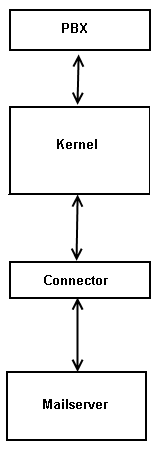ixi-UMS Overview
|
ixi-UMS Enterprise is a powerful unified messaging software, that provides services such as Fax, Voice, SMS and mobile access. The ixi-UMS software is designed modularly and basically consists of the components Kernel, Connectors and Services. The ixi-UMS Kernel is the core of the software and handles all the outward communication processes. The ixi-UMS Connectors provide the integration in different systems like e.g. Microsoft Exchange, Lotus Domino or SAP. The ixi-UMS Services can be combined with each other flexibly. That way, ixi-UMS can be applied as pure fax server, for example, or as a complete unified messsaging system with Fax, Voice and SMS. As it is based on standards, ixi-UMS can basically be operated with all the common PBX's (conventional or IP-based).
Funktion:A professional, server-based Unified Messaging system exists of several components: A phone binding (PBX), the interface between computer and phone system (here the so-called. Kernel), a connection with the mail server (Connector) and the mail server.
The connection by ixi-UMS Connectors is "independent" of the ixi-UMS Kernel. The data exchange is done via Connector directories. This is why it is possible that one single ixi-UMS Kernel can collaborate with one or several Connectors. Another possible constellation is that several ixi-UMS Kernels collaborate with one or several Connectors (e.g. for reasons of high availability).
Connectors and Interfaces:
·ixi-UMS Mail Server Connector - for all mail systems and LDAP databases. ·ixi-UMS SI CON Connector - for the integration in SAP-systems without LDAP-based user management ·ixi-UMS FAPI Connector – File API for the connection of own applications without LDAP-based user management
For more detailed information, please have a look at the respective ixi-UMS Connector manual.
Before outgoing messages can be sent by the ixi-UMS Kernel, they have to be "converted" in a respective format. This process is called "rendering". There are two ways of rendering with ixi-UMS Enterprise. ·server-based rendering ·client-based rendering
Server-based rendering
With server-based rendering, all the file attachments are processed at a central point. For this, the application that shall be sent as fax has to be installed on the respective machine. If a Word-file is attached to the fax, for example, it is passed on to the ixi-UMS Connector by the mail server, e.g. Microsoft Exchange Server, and then passed on to the Render Connector affiliated in the ixi-UMS Kernel.
It "opens" the Word-document and prints it via a particular printer. Therewith, a file is created that contains a graphical image as well as information, e.g. the sender number.
This file is passed on to the ixi-UMS Kernel.
Client-rendering
Client-rendering means the creation of a fax at the user workstation. For this, "Client Tools" are needed that provide an own printer, amongst others. Via this printer, a fax-capable file can be created out of any application installed.
With this type of rendering, the application is not needed on the server.
|
Version 8.00
